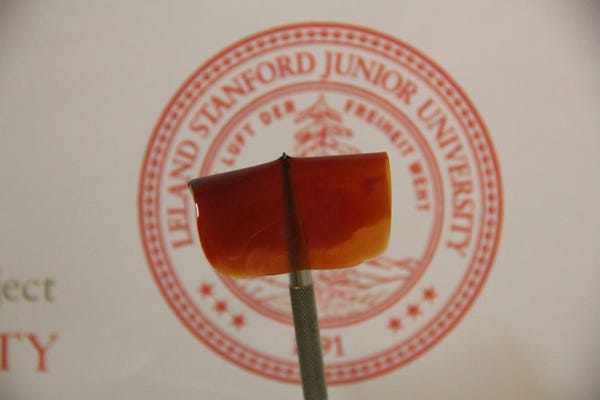This New Super Material Could Enable Artificial Muscles
April 19, 2016
Researchers at Stanford University combined an elastomer with metal ions to create a substance that could one day be used in a self-healing artificial muscle.
Nancy Crotti
|
The new, extremely stretchable polymer film out of Stanford University can repair itself when punctured. (Image courtesy of Stanford University) |
Scientists have been trying for years to invent an artificial muscle that heals itself. Now a team at Stanford University has done it--a first in a field that's been developing for decades.
First, however, visiting scholar Cheng-Hui Li found that a 1-in. elastomer he had just synthesized could stretch more than 100 in.--more than twice the length that the lab's clamping machine could handle. Normally, this type of material could only stretch two to three times its original length, according to a statement from Stanford.
Then the team discovered that the material could heal itself at temperatures as cold as a commercial walk-in freezer, even if the damaged pieces had aged for days. Damaged polymers typically require a solvent or a heat treatment to restore their properties.
An article in Nature Chemistry explains how the team, led by chemical engineering professor Zhenan Bao, made the material and how it works. The implications for its prospects include a new generation of wearable electronics, or medical implants that would last a long time without being repaired or replaced, according to the university.
The team believes that advances in the chemical bonding process known as crosslinking account for the new material's extreme stretching and self-healing properties. Crosslinking, which involves connecting linear chains of linked molecules in a fishnet-style pattern, has previously yielded a tenfold stretch in polymers.
The team created a series of structures called ligands from organic molecules that attach to the short polymer strands in their crosslink. The ligands joined to form longer, spring-like polymer chains. They added metal ions, which are chemically attracted to ligands. When the material is strained, the knots loosen, allowing the ligands to separate. But when relaxed, the affinity between the metal ions and the ligands pulls the fishnet taut. The result is a strong, stretchable and self-repairing elastomer, according to the university.
"Each metal ion binds to at least two ligands, so if one ligand breaks away on one side, the metal ion may still be connected to a ligand on the other side," Bao explained in the statement. "And when the stress is released, the ion can readily reconnect with another ligand if it is close enough."
By varying the amount or type of metal, the team found that they could fine-tune the polymer to be stretchier or heal faster. For the version that exceeded the measuring machine's limits, they decreased the ratio of iron atoms to the polymers and organic molecules.
Then they found that the metal-added polymer could twitch in response to an electric field. A short video provided by the university shows how it works. The team will be working on how to increase the degree to which the material expands and contracts and control it more precisely so that it one day might be used as artificial muscle.
"The goal was not to make the best artificial muscle, but rather to develop new materials design rules for stretchable and self-healing materials," Bao explained in a report in Science. "Artificial muscle is one potential application for our materials."
Other researchers have been hard at work materials that could comprise artificial muscle and self-healing bone. A team at Northwestern University is developing a polymer that has both rigid and soft nanoscale compartments, permitting it to lift objects. The material could potentially be used to deliver drugs, biomolecules, or other chemicals. In addition, it could be used to create materials capable of self-repairing.
Researchers at the University of Michigan have created a polymer sphere that delivers a specific molecule to bone wounds to help them heal.
Bao was already working on creating artificial skin that might be used to restore some sensory capabilities to people with prosthetic limbs. Her team previously created flexible but fragile polymers, studded with pressure sensors to detect the difference between a handshake and a butterfly landing, the university said.
Learn more about cutting-edge medical devices at MD&M East, June 14-15, 2016 in New York City. |
Nancy Crotti is a contributor to Qmed and MPMN.
Like what you're reading? Subscribe to our daily e-newsletter.
About the Author(s)
You May Also Like


.png?width=300&auto=webp&quality=80&disable=upscale)
